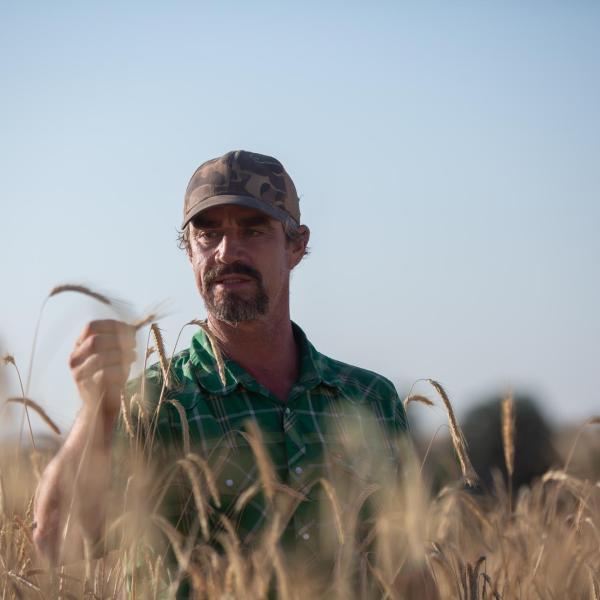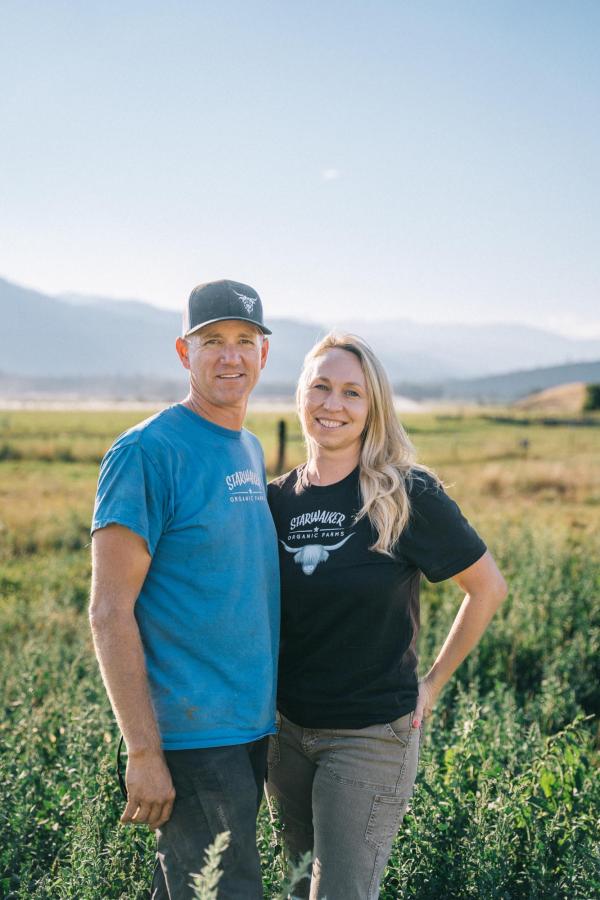
Cultivating Conservation
Voicing the Impact of Farm Bill Funding
USDA conservation programs are a critical national investment in our working landscapes and environment. For farmers and ranchers, these programs offer essential financial and technical support to implement and maintain conservation practices or to take land out of production. As the map below demonstrates, these programs serve farmers across the entire country, with the most funding going towards key agricultural states in the Upper Midwest, Northern Great Plains, and Southern Great Plains regions.
However, these programs are consistently oversubscribed, signaling a growing demand for funding that far exceeds current availability. To sustain the momentum of conservation efforts across the U.S., we must protect, expand, and advocate for these vital resources.
This platform is dedicated to showcasing the critical role of USDA conservation programs through a blend of data and stories from the farmers and ranchers who make it all possible.

Bridging Data with Stories
The true impact of USDA conservation programs goes beyond numbers. By centering the voices of those directly impacted, we hope to bring conservation practices on working land to life, turning abstract data into compelling, human stories that inspire action. Mad Agriculture partnered with 9 farmers and ranchers across the country that covered:
8 States: Minnesota, Hawaii, California, Louisiana, South Dakota, Montana, Wyoming and Michigan
62,206 acres: cumulatively managed
26 EnterpriseS: including vegetables, small grains, corn, soy, wheat, alfalfa, hay, animal feed grains, pulses, legumes, and fruits like apples, peaches, and cherries. They also produce grapes, wine, and duck and chicken eggs. Livestock includes cattle, hogs, sheep, goats, poultry, and Galloway breeding stock.
18 project types: a range of innovative and sustainable practices, including no-till organic methods with crimping roller implements for weed barrier mulch, establishment of pollinator hedgerows and bat boxes, and participation in the Pollinator Monarch Habitat Program. Additional initiatives involve constructing high tunnels, wells, cross fencing, and water facilities to support livestock and pollinator habitats. Practices also include nutrient management, intensive rotational grazing, mulching for weed control, interseeding forbs and legumes, and developing composting facilities.
Farmer Stories









Understanding USDA Conservation Programs
The United States Department of Agriculture (USDA) manages a number of programs that provide financial and technical assistance to farmers and ranchers looking to implement conservation practices, remove land from production, or place land under a conservation easement. The five largest programs are:
In addition to these large USDA programs, there are other valuable conservation initiatives, such as the Sustainable Agriculture Research and Education (SARE) program. SARE advances agricultural innovation that promotes profitability, stewardship of the land, air and water, and quality of life for farmers – it is funded through the National Institute of Food and Agriculture (NIFA). Although this data is not reflected in our visualizations, we have shared stories related to this funding source because it plays a crucial role in directly supporting the implementation of conservation practices on farms.
These programs are more than just funding sources—they’re vital tools that help farmers improve soil health, water quality, and wildlife habitat on their land. Each program has specific goals and offers a range of conservation practices that farmers can select based on their unique needs.
The EQIP funding has allowed us to utilize land that is not only more efficient with irrigation but also beautifully enhanced through regenerative practices.
Kristina Walker

Kristina & Jason Walker
California
Kristina and Jason Walker are the third-generation owners of Starwalker Organic Farms, which they took over in 2012 from Jason’s family. The farm spans about 3,500 acres in Scott Valley, California surrounded by mountains. They raise highland cattle, hogs, and produce a variety of crops, including alfalfa, wheat, and peas, keeping a closed nutritional loop on-farm. The Walkers are committed to organic farming, a tradition that has been in place for over 40 years on their land. They see organic practices as essential for maintaining soil health and producing high-quality, sustainable food. The Walkers prioritize the health of their soil and land through organic and regenerative practices, utilizing animals for natural fertilization and carbon storage.
Farm Bill Funding
All of these programs were established through the U.S. Farm Bill, a comprehensive agricultural and food policy bill that is renewed roughly every five to six years. The 2018 Farm Bill (Agriculture Improvement Act of 2018), Title II, includes all the conservation programs and allocated $60 billion in funds for mandatory spending over a 10 year period.
More recently, the Inflation Reduction Act (IRA of 2022) infused an additional $19.5 billion into conservation programs over a five year period (2023-2028). The IRA, a budget reconciliation bill stemming from the Biden administration’s Build Back Better campaign, had a partial focus on investing in climate change mitigation efforts. The future of these critical investments remains at risk as debates over funding persist. These IRA funds will increase the amount of annual funding towards conservation programs by $3.9 billion, a 2/3 increase.


Donna Isaacs
Louisiana
Donna Isaacs’ passion for agriculture was deeply influenced by her upbringing in Jamaica, where she grew up on a 20 acre permaculture food forest surrounded by mango, breadfruit, and bananas, as well as pigs and broiler chickens. This rich experience with a variety of crops and livestock instilled in her the value of living off the land, though as a child she did not initially recognize it as permaculture.
Farmer Access
The demand for conservation funding is immense. According to the Bipartisan Policy Center, only 30% of EQIP applications and 35% of CSP applications were accepted in recent years, highlighting the need for continued and increased investment.
Farmers and ranchers can apply for these programs through their local USDA offices. EQIP and CSP, as well as CRP and RCPP in some cases, require that applicants select a specific practice or practices to implement on their property from the Conservation Practice Standards. As you dig into our data visualizations you will see these codes referenced. The standards include a broad range of different practices for different farming systems, including, for example, planting buffer strips, installing irrigation, or developing a grazing management plan. Funding allocation varies by state, as each prioritizes different practice standards and resource concerns.

Josiah & Sarah Harder
South Dakota
Josiah and Sarah Harder own and operate Arrow J Acres, a grass-based cattle operation located near Fort Pier, South Dakota. Though originally from South Dakota, Josiah spent most of his childhood in Wisconsin, where he gained agricultural experience working on dairy farms. In 2022, he completed a summer internship with a ranch ministry in South Dakota, where he learned ranching skills and connected with the landowners from whom he now leases pasture land.
Distribution of Funds
Sunburst diagram of federal funding for conservation programs, 2014-2024
Inflation-adjusted to 2023 dollar equivalents. Innermost wedges represent the total funding spent in the 5 major conservation programs. Clicking through each wedge will then bring up funding allocation in different subcategories, such as funding type and, for EQIP and CSP, practice categories and specific practices. Download data to full Conservation Practice Standards index.
[ Click around! ]

Alice Anderson
California
Alice Anderson is a winemaker and grape grower in Santa Barbara County, California, focusing on production in Santa Ynez, Los Olivos District, Santa Ynez, and the Alisos Canyon. The region’s beautiful landscape is characterized by steep mountains that quickly drop into the Pacific Ocean and valleys that are dry with striking Golden Hills, valley oaks, and rocky outcroppings. Alice’s vineyards are nestled in this scenic environment, offering a unique setting for growing grapes.
In Comparison to Total Conservation Investment
USDA conservation program investments from 2014-2024 totaled $59.7 billion (adjusted for inflation), representing 15% of the $321.1 billion estimated total for investable strategies in U.S. conservation agriculture, according to the Croatan Institute’s 2019 report.
The USDA investments highlight a diverse range of practices, with CRP and CSP focusing directly on land and resource management, while EQIP’s infrastructure practices offer more indirect benefits through enhanced efficiency and reduced pollution. Below are some different starting points from our data set to see the relative investments of CSP, EQIP and CRP.

Raia Olsen
Hawaii
Raia Olsen and her husband, Daniel, own and operate two livestock companies, Oahu Grazers, a solar sheep grazing operation, and Flying W Ranch, a cow-calf operation on the North Shore of Oahu. Raia and Daniel were both brought up in ranching and rodeo families but never planned on owning their own ranch until they were gifted 20 sheep in 2014. They took the opportunity to begin building their sheep flock and developing their solar projects. Their four young children are deeply involved in the farm.
Conservation Stewardship Program (CSP):
$12 billion, with the majority of funds dedicated to cropland conservation practices, including Cropland Annual Payments (CROP).
Establishing Monarch Pollinator Habitat around my organic fields creates a buffer against potential pesticide and GMO pollen drift, benefiting both my crops and those of neighboring farmers.
Andrew Barsness

Andrew Barsness
Minnesota
Andrew Barsness began farming organic grains near Hoffman, Minnesota, in 2011 on his grandparents’ farm after their passing. Initially unsure of his career path while studying at the University of Minnesota in Morris, Andrew felt compelled to carry on the family farming tradition. He started by renting a field from his mother and aunt, who inherited the farm, and quickly fell in love with farming. This passion led him to change his major from music and pottery to farm and ranch management.
Environmental Quality Incentives Program (EQIP):
$17 billion, with the largest percentage of funding allocated to farm infrastructure improvements. This includes seven of the ten most funded practices such as installing irrigation systems (442, 430, 441), livestock infrastructure (382, 516), and waste management structures (313, 367). The most funded individual practice under EQIP was the planting of cover crops (340).

John Wicks
Montana
John Wicks farms 4,000 acres in the Golden Triangle of central Montana, a region famous for producing high-quality wheat. His land consists of dryland and small grass rangeland. John is an outspoken proponent for ecologically-appropriate agriculture and prides himself on running his grain operation without irrigation. In response to the changing agricultural landscape John has begun incorporating pulse crops and lentils into his rotations.
Conservation Reserve Program (CRP):
About 40% of total funds, with $22 billion directed primarily to rental payments, supporting direct improvements to land and natural resources.

Kyle Rasch
Michigan
Kyle Rasch, the owner of Third Leaf Farm in Greenville, Michigan, is a third-generation apple farmer continuing his family’s legacy, which began over 60 years ago with Tom Rasch and Son Orchards. With a primary focus on apples, the farm also grows peaches, cherries, and other fruits. Over time, the farm has shifted from conventional farming practices to more organic and regenerative methods. Their approach incorporates biodiversity through wildflowers, cover crops, and natural ecosystems, including bee colonies managed by Kyle’s brother, Eric.
Environmental Impact
Conservation practices supported by these programs have demonstrated potential to improve soil health, reduce environmental damage, and sequester carbon in soils or biomass. Returning agricultural land to natural habitats, such as hedgerows or grasslands, enhances carbon sequestration and provides critical wildlife habitat. A 2020 article [12] by agricultural researchers suggested that directing USDA conservation funding toward the most impactful practices could significantly benefit U.S. agricultural lands.
While these programs are generally effective, studies show mixed results or unintended consequences, such as CRP grasslands reducing groundwater recharge. However, evidence overall indicates a positive environmental impact.
Conservation Reserve Program (CRP):
Soil Carbon: Several studies indicate increased soil carbon stocks under CRP, although results vary depending on prior land use and ecological factors [1, 2, 3, 4]. Modeling studies suggest that maintaining converted grasslands under CRP can enhance soil carbon, while converting back to cropland may result in carbon losses [5, 6].
Habitat: CRP provides significant habitat for migratory and resident bird species [7, 8, 9]. Mixed Impacts:
Some studies suggest mixed results or unintended consequences, such as CRP grasslands potentially reducing groundwater recharge.
Environmental Quality Incentives Program (EQIP):
Water Quality: A comprehensive study found that EQIP practices have reduced organic matter and nitrogen levels in downstream watersheds but may have increased fecal solids and phosphorus [10].
Cover Crops: A 2021 review noted that increased adoption of cover crops in the U.S. was partly attributed to EQIP and CSP [11].

RC Carter
Wyoming
RC Carter, a fourth-generation cattle rancher, manages a sprawling operation three miles north of Ten Sleep, Wyoming, at the base of the Bighorn Mountains. His ranch spans 7,000 acres of deeded rangeland, and with leases from the BLM and other sources, it totals nearly 50,000 acres. Carter’s focus is on grass-fed beef production, particularly on his 500 acres of irrigated hay production, which supports his livestock through the winter.
Conclusion
USDA conservation programs are essential for advancing regenerative agriculture and environmental stewardship in the U.S. They provide crucial financial and technical support to farmers and ranchers, enhancing soil health, water quality, and wildlife habitat. Recent funding boosts from the Inflation Reduction Act have broadened the reach of these programs, yet demand still outstrips available resources. While some impacts are complex or mixed, the overall benefits—such as improved soil carbon sequestration and water quality—are substantial and necessary for tackling environmental challenges.
To maintain and expand these benefits, increased and sustained funding is critical. By directing resources to the most impactful practices and addressing areas for improvement, we can enhance the effectiveness of these programs. Investing in USDA conservation efforts is a commitment to a healthier, more resilient agricultural landscape that supports both the environment and rural communities. As we confront growing environmental pressures, supporting these programs is crucial for achieving long-term sustainability in our agricultural systems.
Environmental Quality Incentives Program (EQIP): EQIP provides financial and technical assistance to agricultural producers to implement conservation practices that address natural resource concerns, improve water and air quality, and enhance wildlife habitat. Qualified practices include a range of practices including, for example, planting cover crops, installing irrigation systems, or developing a grazing management plan.
Conservation Stewardship Program (CSP): CSP offers payments to farmers and ranchers for maintaining and enhancing conservation practices on their land. Often, producers start these practices via EQIP and then use CSP to secure continuing support to implement those practices. CSP applicants are ranked based on how well they address state conservation priorities and cost effectiveness, with only a portion of the top-ranked applications receiving awards.
Regional Conservation Partnership Program (RCPP): RCPP promotes partnerships between agricultural producers and other stakeholders to implement conservation projects that address regional or watershed-scale resource concerns. Partner organizations include universities, consumer product groups, and non-profit organizations. RCPP programs can also leverage other USDA programs, such as EQIP and CSP, to more efficiently deliver assistance from those programs to farmers and ranchers.
Conservation Reserve Program (CRP): CRP pays farmers to remove environmentally sensitive land from agricultural production and plant species that will improve environmental health, helping to reduce soil erosion, enhance water quality, and increase wildlife habitat. Payments are determined on a per-country basis and are based on per-acre rental rates. Contracts are typically 10-15 years in length, although some areas qualify for the CLEAR30 program under CRP, which implements 30 year contracts.
Agricultural Conservation Easement Program (ACEP): ACEP provides funding to help protect and restore agricultural lands and wetlands by assisting landowners in implementing easements on their lands.
Technical Assistance: involves providing expert guidance, planning, and support to farmers and landowners to help them implement conservation practices effectively.
Financial Assistance: involves direct payments or cost-sharing to help cover the expenses of implementing qualified conservation practices.
Reimbursable Assistance: Under this model, farmers or landowners first pay for approved conservation practices and then receive reimbursement from the USDA after demonstrating that the practices have been implemented as agreed.